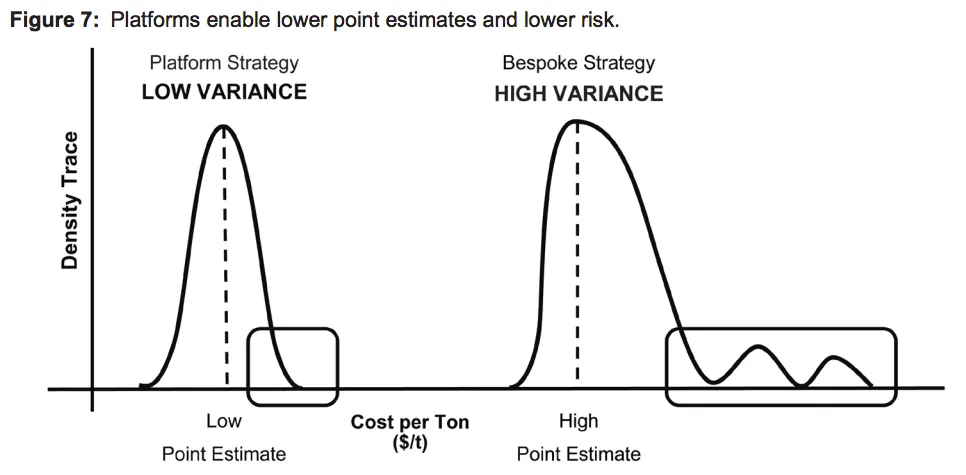Previously, we discussed the Iron Triangle of project performance and how project teams can more effectively control costs by focusing on time management.
In this blog post, we are going to “bust” the myth of the Iron Triangle by showing how those constraints are manufactured. Using our case study of the space industry, this post will illustrate that a successful platform strategy is not only faster and cheaper, but it also lowers risk.
Project Constraints Are Manufactured — Not Real
I want to begin my argument by illustrating the difference in efficiencies between the public and private sectors. The illustration below provides visualisation of how moving from a bespoke strategy not only lowers the point estimate, it also compresses the variance around the point estimates.

Now to bring this concept into the world, let’s discuss how SpaceX missions are not only many times cheaper than conventional missions, they carry far less risk.
This phenomenon isn’t just confined to the space industry, either. Consider these additional examples:
- Containerized shipping is 99 per cent cheaper, 90 percent faster, and carries 30X the trading volume compared with the pre-platform era.
- Computing cycles are billions of times cheaper and faster.
- Platform companies such as Apple and Microsoft command multi-trillion-dollar valuations that exceed the GDP of the United Kingdom—the world’s sixth-largest economy.
The benefits of platforms are now widely understood in business practice and management. Conventional economics and policy, however, have substantial catching up to do. Sectors of the economy where government finds it difficult to control spending, timeframes, or getting the benefits quickly enough — e.g. health, education, climate, and defence — are ripe for a platform rethink.
It’s Time For a Platform Rethink
Platforms defy the Iron Triangle myth. The Iron Triangle is sometimes also called the Project Management Triangle or the Triple Constraint.
The three corners of the Iron Triangle are made up of the variables scope, cost, and schedule. According to this model, those three variables are interrelated in a zero-sum game where building a larger scope is thought to require more cost and time. Conversely, to build something faster is thought to either cost more or require smaller scope or both. The economics of platforms shows such conventional thinking to be mistaken.
For example, SpaceX delivers far greater scope—volume and variety of space cargo—than even its proponents had imagined. And it does it 10X cheaper and 2X faster than the conventional approach.
Platforms defy the Iron Triangle. In fact, whether something can break the constraints of the Iron Triangle is a test for whether it will scale. The ability of well-executed platforms to defy the Iron Triangle presents a source for grounded optimism in the delivery of big projects. Not all big problems are as intractable as they appear.

Defying The Iron Triangle
Big problems typically require a scale (many units of outputs) and variety (many kinds of outputs). Populating outer space, as SpaceX aspires to do, is a big problem that will require a much larger volume of launches than is currently possible. Moreover, high-volume space ferrying will need to handle an increased variety of cargo: large numbers of people, tools, and heavy equipment brought from Earth to space, resources mined in one part of space transported for use in another part, etc.
Conventional thinking stipulates a trade-off between volume and variety. NASA’s one-off missions had a great deal of variety—the doomed Mars Observer carried eight instruments for scientific discovery worth US$479 million. But even if the Mars Observer had succeeded, its sequel would have taken just as much time and money to refashion each element.
In contrast, platforms are designed for repeatability through modularity. The initial advantage of this repeatability is to increase homogeneous volume. Once that repeatability is predictable, variety follows at scale by combining modules in different ways.
In a virtuous cycle, variety unlocks more volume. For example, SpaceX first achieved repeatable and reliable launches of its Falcon 9 rocket, which brought about significant cost reductions, which allowed lower prices, which spurred demand. Then SpaceX began bundling payloads of different sizes to drive down costs further.
Thus, as a platform grows, its ability to serve a greater scale and scope of services increases disproportionately.
Build Faster, Better, Cheaper, and With Lower Risk
By fundamentally challenging conventional thinking around major projects and their inherent risk, a platform approach has made possible feats that only decades ago would have been unimaginable.
Governments and businesses should adopt a platform strategy like that of SpaceX to reduce risk and prevent failures. In the context of the climate crisis and increasing levels of political uncertainty, it has become more imperative than ever that governments manage the myriad of challenges they face with minimised risk and high levels of adaptability to change. The answer to this is a platform approach.
Build faster, better, cheaper, and with lower risk using Foresight AI Engine, the only AI scheduling platform that unlocks the full value of your schedule data. Book a demo today to discover how Foresight can help you.


